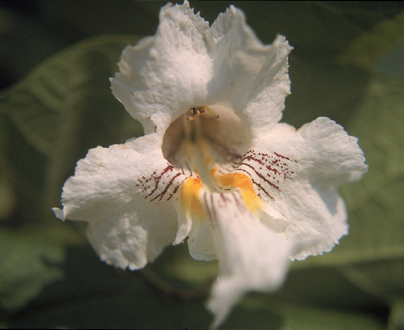
Past
landscapers have used this tree for its stately form.As
mentioned earlier, many feel that the tree does not maintain its leaves
well throughout the season [Missouri].In
the fall, leaves turn a yellow color which is not as striking as other
choices.Throughout the year, the
large leaves may be damaged by weather. The
unusual aesthetic impact of the large seed pods may outweigh the maintenance
they cause in some consumers minds.Perhaps
there is hope if a variety can be designed to hold the fruit longer, or
create female only trees.Flowers
of this tree are very nice while they last.In
the past they have been grown for use in fence posts as a economic value.
For
focus in this paper we will look at the hardier variety of the species, Catalpa
speciosa.It is also known as the
Northern Catalpa, Hardy Catalpa, Western Catalpa, Catawba, or Cigar tree.Hardiness
is a characteristic that growers in northern
The
family is Bignoniaceae.Other
members of this family are Trumpet Vine, Royal Paulownia, and other species
of Catalpa, all of which are known for their showy flowers [
Typically
grown in the Midwestern US, this variety is hardy to zone 4.This
means that is can be grown in
Catalpa
trees have tropical background and need full sun to partial shade.It
is ideal for low lying areas that are moist, as it prefers medium to wet
soil conditions.Seasonal flooding
is not a problem for this species.It
can also tolerate dry conditions and thus is versatile for location.Ideal
soil is rich but, as stated, any soil will work.
There
are very few problems associated with Catalpa trees.Leaf
spotting and damage from insects such as the catalpa sphinx moth can cause
substantial damage on occasion.However,
from a domestic standpoint, the main cost is in season maintenance associated
with pod clean-up.

Flowers
are white with yellow and purple inner spots, appearing much like foxgloves.These
are perfect flowers, so if one wishes to avoid fruiting, new designed varieties
would need to be made.
Northern Catalpa Profile:
Family:
Bignoniaceae
Genus:
Catalpa
Species:
speciosa
Type:
Tree
Zone:
4
to 8
Location:
Midwestern US
Height:
40� to 70�
Spread:
20� to 50�
Full Sun to Part Shade
Water:
Medium to wet
Blooms:
White with yellow and purple inner spots
Many blossoms form starting in early summer (May to June).Flowering does not begin until a tree is about 15 years old.Probably one of the major defining characteristics are the long (20 inches), brown seed pods.Trees can attain heights of 35 to 40 feet.Care should be taken when selecting this tree, as its size and large shade zone can cause problems in a small area.
| NEXT: Methods
Table of Contents Christopher.Besemann@ndsu.nodak.edu March 2003 |